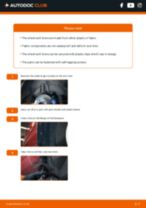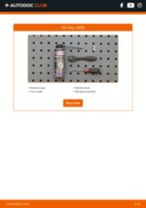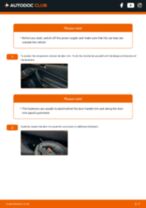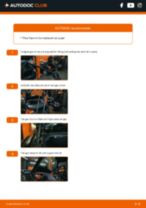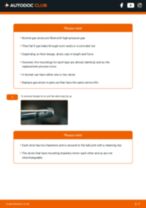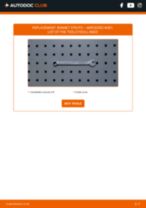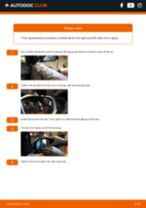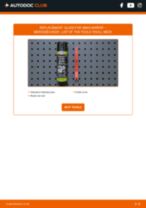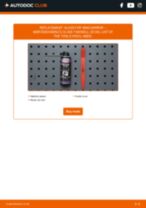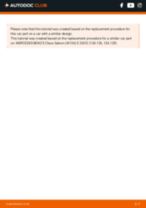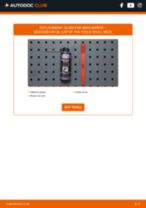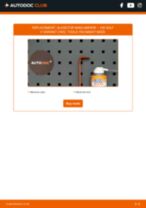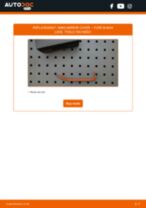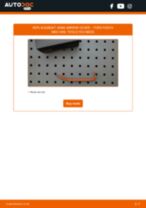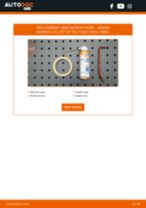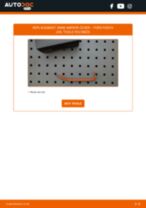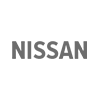Manuals and tips on repair and maintenance for Body
Body parts replacement: Step-by-step manuals
Want to get more useful information?  Ask on the forum
Ask on the forum
Ask questions or share your repair experience on the car forum. Subscribe to updates so you don't miss out on new guides.
Body: replacement and repair guides
Body: Most viewed car repair video tutorials
Wheel Arch Cover
Go to section
 How to change mudguard panelling [AUTODOC TUTORIAL]
How to change mudguard panelling [AUTODOC TUTORIAL]
Radiator Support
Go to section
 How to change bumper grill on AUDI A6 C5 Avant [TUTORIAL AUTODOC]
How to change bumper grill on AUDI A6 C5 Avant [TUTORIAL AUTODOC]
Wing Mirror
Go to section
 How to change Wing Mirror on SUZUKI SX4 1 TUTORIAL | AUTODOC
How to change Wing Mirror on SUZUKI SX4 1 TUTORIAL | AUTODOC How to change Wing Mirror on OPEL CORSA C TUTORIAL | AUTODOC
How to change Wing Mirror on OPEL CORSA C TUTORIAL | AUTODOC How to change wing mirror / mirror / door mirror FORD FIESTA JA8 [TUTORIAL AUTODOC]
How to change wing mirror / mirror / door mirror FORD FIESTA JA8 [TUTORIAL AUTODOC] How to replace wing mirror NISSAN QASHQAI (J10, NJ10) [TUTORIAL AUTODOC]
How to replace wing mirror NISSAN QASHQAI (J10, NJ10) [TUTORIAL AUTODOC] How to replace wing mirror FORD FOCUS 2 [TUTORIAL AUTODOC]
How to replace wing mirror FORD FOCUS 2 [TUTORIAL AUTODOC] How to replace wing mirror FORD FOCUS (DAW) [TUTORIAL AUTODOC]
How to replace wing mirror FORD FOCUS (DAW) [TUTORIAL AUTODOC] How to replace wing mirror OPEL CORSA S93 [TUTORIAL AUTODOC]
How to replace wing mirror OPEL CORSA S93 [TUTORIAL AUTODOC] How to replace wing mirror MERCEDES W124 [TUTORIAL AUTODOC]
How to replace wing mirror MERCEDES W124 [TUTORIAL AUTODOC]
Door Lock
Go to section
 How to replace your car door lock [AUTODOC TUTORIAL]
How to replace your car door lock [AUTODOC TUTORIAL] How to change door lock VW GOLF 5 [TUTORIAL AUTODOC]
How to change door lock VW GOLF 5 [TUTORIAL AUTODOC] How to change door lock SEAT IBIZA 3 6L [TUTORIAL AUTODOC]
How to change door lock SEAT IBIZA 3 6L [TUTORIAL AUTODOC] How to change door lock SEAT LEON 1M1 [TUTORIAL AUTODOC]
How to change door lock SEAT LEON 1M1 [TUTORIAL AUTODOC] How to change an exterior door handle and lock on the FORD TRANSIT MK7 [AUTODOC TUTORIAL]
How to change an exterior door handle and lock on the FORD TRANSIT MK7 [AUTODOC TUTORIAL]
Door Handles
Go to section
 How to change door handle on NISSAN QASHQAI (J10, NJ10) [TUTORIAL AUTODOC]
How to change door handle on NISSAN QASHQAI (J10, NJ10) [TUTORIAL AUTODOC] How to change an exterior door handle and lock on the FORD TRANSIT MK7 [AUTODOC TUTORIAL]
How to change an exterior door handle and lock on the FORD TRANSIT MK7 [AUTODOC TUTORIAL] How to change the outer front door handle on the RENAULT MASTER 2 Van [AUTODOC TUTORIAL]
How to change the outer front door handle on the RENAULT MASTER 2 Van [AUTODOC TUTORIAL]
Tailgate Struts
Go to section
 How to change the tailgate struts on your car [AUTODOC TUTORIAL]
How to change the tailgate struts on your car [AUTODOC TUTORIAL] How to change gas struts / tailgate struts on VW POLO 4 (9N) [TUTORIAL AUTODOC]
How to change gas struts / tailgate struts on VW POLO 4 (9N) [TUTORIAL AUTODOC] How to change gas struts / tailgate struts on BMW E46 Touring [TUTORIAL AUTODOC]
How to change gas struts / tailgate struts on BMW E46 Touring [TUTORIAL AUTODOC] How to change gas struts / tailgate struts on VW GOLF 5 (1K1) [TUTORIAL AUTODOC]
How to change gas struts / tailgate struts on VW GOLF 5 (1K1) [TUTORIAL AUTODOC] How to change tailgate struts on FORD FOCUS 2 TUTORIAL | AUTODOC
How to change tailgate struts on FORD FOCUS 2 TUTORIAL | AUTODOC How to change gas struts / tailgate struts on AUDI A3 2 (8PA) [TUTORIAL AUTODOC]
How to change gas struts / tailgate struts on AUDI A3 2 (8PA) [TUTORIAL AUTODOC] How to change gas struts / tailgate struts on OCTAVIA (1Z5) [TUTORIAL AUTODOC]
How to change gas struts / tailgate struts on OCTAVIA (1Z5) [TUTORIAL AUTODOC] How to change gas struts / tailgate struts on MERCEDES-BENZ B200 (W245) [TUTORIAL AUTODOC]
How to change gas struts / tailgate struts on MERCEDES-BENZ B200 (W245) [TUTORIAL AUTODOC]
Hood
Go to section
 How to replace bonnet gas struts [AUTODOC TUTORIAL]
How to replace bonnet gas struts [AUTODOC TUTORIAL] How to change bonnet struts VW Passat [TUTORIAL AUTODOC]
How to change bonnet struts VW Passat [TUTORIAL AUTODOC] How to change a bonnet struts on MERCEDES-BENZ M W163 TUTORIAL | AUTODOC
How to change a bonnet struts on MERCEDES-BENZ M W163 TUTORIAL | AUTODOC How to change bonnet struts on AUDI A6 C5 Avant [TUTORIAL AUTODOC]
How to change bonnet struts on AUDI A6 C5 Avant [TUTORIAL AUTODOC] How to change bonnet struts on MERCEDES W201 [TUTORIAL AUTODOC]
How to change bonnet struts on MERCEDES W201 [TUTORIAL AUTODOC] How to change a bonnet strut on the RENAULT DUSTER 1 [AUTODOC TUTORIAL]
How to change a bonnet strut on the RENAULT DUSTER 1 [AUTODOC TUTORIAL]
Glass For Wing Mirror
Go to section
 How to replace side mirror glass [AUTODOC TUTORIAL]
How to replace side mirror glass [AUTODOC TUTORIAL] How to change glass for wing mirror MERCEDES-BENZ W211 E-Class [TUTORIAL AUTODOC]
How to change glass for wing mirror MERCEDES-BENZ W211 E-Class [TUTORIAL AUTODOC] How to change glass for wing mirror OPEL CORSA D [TUTORIAL AUTODOC]
How to change glass for wing mirror OPEL CORSA D [TUTORIAL AUTODOC] How to change glass for wing mirror NISSAN QASHQAI (J10, NJ10) [TUTORIAL AUTODOC]
How to change glass for wing mirror NISSAN QASHQAI (J10, NJ10) [TUTORIAL AUTODOC] How to change glass for wing mirror / side mirror glass OCTAVIA (1Z5) [TUTORIAL AUTODOC]
How to change glass for wing mirror / side mirror glass OCTAVIA (1Z5) [TUTORIAL AUTODOC] How to change glass for wing mirror OPEL ASTRA H Saloon [TUTORIAL AUTODOC]
How to change glass for wing mirror OPEL ASTRA H Saloon [TUTORIAL AUTODOC] How to replace glass for wing mirror MERCEDES W168 [TUTORIAL AUTODOC]
How to replace glass for wing mirror MERCEDES W168 [TUTORIAL AUTODOC] How to change glass for wing mirror VW T5 TRANSPORTER Van [TUTORIAL AUTODOC]
How to change glass for wing mirror VW T5 TRANSPORTER Van [TUTORIAL AUTODOC]
Wing Mirror Covers
Go to section
 How to replace wing mirror cover FORD FIESTA JA8 [TUTORIAL AUTODOC]
How to replace wing mirror cover FORD FIESTA JA8 [TUTORIAL AUTODOC] How to replace wing mirror cover NISSAN QASHQAI (J10, NJ10) [TUTORIAL AUTODOC]
How to replace wing mirror cover NISSAN QASHQAI (J10, NJ10) [TUTORIAL AUTODOC]
Body: Top repair guides
Wheel Arch Cover
Go to section
Wing Mirror
Go to section
Door Lock
Go to section
Door Handles
Go to section
Tailgate Struts
Go to section
Glass For Wing Mirror
Go to section
Wing Mirror Covers
Go to section
Lifehacks from AUTODOC CLUB
 Three ways to change oil without a lift
Three ways to change oil without a lift 5 possible reasons why your car heater isn't working
5 possible reasons why your car heater isn't working How to clean the engine bay perfectly
How to clean the engine bay perfectly How I started restoring a driveshaft | Drivetrain restoration – Part 1
How I started restoring a driveshaft | Drivetrain restoration – Part 1
Unlock your car maintenance assistant!
Track expenses, manage logs, schedule replacements, and more.
Common questions about checking and repairing the car body
AUTODOC's car repair and service guides

Time to replace parts? Get even better deals in our Shop app.

SCAN ME

















